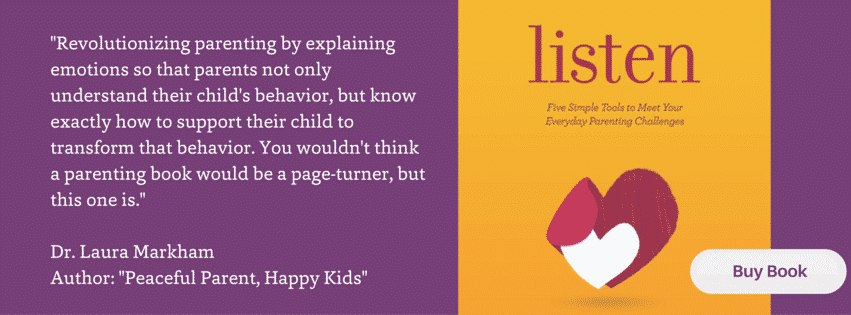What is Hand in Hand Parenting?: Day 8![]()
In the last of our series of Listen Launch Posts, Patty Wipfler talks about how children's deep down fears can erupt in patterns of aggression and how releasing those fears comes through a loving and supportive presence.
Unlocking Secret Fears
Fear underlies many of our children’s persistent struggles. It makes it hard for them to say a calm goodbye as we head off to work. Fear also drives physical outbursts of aggression, and the impulse to grab rather than wait for a turn. The child who shies away from participating in an activity he loves is probably scared. So is the child who never raises his hand in class, and the one who constantly disrupts.
You may be able to put your finger on a few incidents that might have frightened your child, such as a difficult birth, an accident, an illness, or sudden changes at home, but experiences that seem harmless and matter-of-fact to you can also cause trouble. A few claps of thunder, your car running out of gas on the highway, one shouting match with your partner—any of these events could frighten your child, and make relaxation difficult for him without your help.
If no one listens to the intense feelings that come up the moment a child gets scared, those feelings are stored away, raw and powerful still, in the child’s emotional memory. There they sit uneasily, tangled with information about the sights, sounds, smells, tastes and textures of the experience. So a day, a week, or even years later, your child may experience a flashback, and once again be gripped by that stored fear in the course of his daily life.
Understand the Impulses
A scared child—like scared people of all ages—is suddenly flooded with emotion. He feels unsafe, whether there’s real danger or not. As he reacts, he will fight, flee, or freeze. He needs your presence, but as you’ve probably discovered, your presence alone doesn’t make him feel better. A fearful child feels profoundly alone.
 In defensive fight mode, he may argue, lash out, or grab for something he knows is off limits. If he’s in flight mode, he’ll back away from a situation, refuse to engage, or he may actually run. If the situation is truly overwhelming, so much of his mind shuts down that his protective instincts drain right out of him. Terrified inside, he freezes and acts as if things are normal until the danger passes.
In defensive fight mode, he may argue, lash out, or grab for something he knows is off limits. If he’s in flight mode, he’ll back away from a situation, refuse to engage, or he may actually run. If the situation is truly overwhelming, so much of his mind shuts down that his protective instincts drain right out of him. Terrified inside, he freezes and acts as if things are normal until the danger passes.
Whether he fights, flees, or freezes, your child can’t think when he’s scared. And without help from a caring person, he can’t get his mind back in gear.
When your child shows you he’s scared by lashing out or by shrinking into himself, he is asking for your help. He reacts instinctively, guided by his body’s urge to stay safe. The behavior he uses as his flare isn’t his choice, it’s a distress signal.
His behavior says, “I’m in trouble here!”
Offer Him a Gift of Release
Most of us were taught to avoid feeling afraid at almost any cost, and when adults tried to help us with our childhood fears, the tools they used were crude. They threw us in the swimming pool when we were afraid to swim, or painted our thumbs with a bad-tasting potion to “cure” us of the thumb-sucking that marked our shy moments. These kinds of experiences give us no feel for the art of truly lifting fear from our children’s minds and hearts.
Most children release heavy fear when an unmet expectation, a tiny accident, or some other minor trigger sets off an extraordinary reaction. Suddenly, your child feels deeply threatened. As soon as you arrive, his limbic system senses the safety you bring, and his body goes out of control. Up comes the impulse to run away or to attack. He’ll scream. He may writhe. He will sweat. He may tremble or arch his back. He may battle with you or with unseen forces, screaming all the while. It will look like his mind has left him, and in a way, that’s true.
Terror infuses his entire being. This highly charged process can transform your child’s life—and yours— but it’s challenging. His feelings throw him onto a kind of haunted-house ride through the worst experiences he’s ever had. Yet he is fully aware of your presence. In fact, your presence is what enables him to try and shuck this terrible fear.
Using tools like Special Time to continuously boost his sense of safety and connection, Playlistening to promote the laughter and regular light release coupled with Staylistening, where you stay with your child in support through loud crying and outburst will help lift and release these fears. The aggression will die down and good humor will return.
How long it will take your child to overcome his fear depends upon how scared he is and how safe he feels to show you his fears. If your child has been carrying a load of fear for awhile, it may take a couple of months of focus on Special Time and Playlistening before he can begin work on his deeper fears. Then, working through terror may take many rounds of Setting Limits and Staylistening. But each time you use a Listening Tool, you’ll learn new things and change will come.
This post is adapted from the book Listen: Five Simple Tools To Meet Your Everyday Parenting Challenges by Patty Wipfler and Tosha Schore.
From the Hand in Hand Toolbox
- Read about the Five Tools That Will Transform your Parenting and how they closeness to you and your child
- Help your child's aggression with this free video series
- Buy the book Listen.

